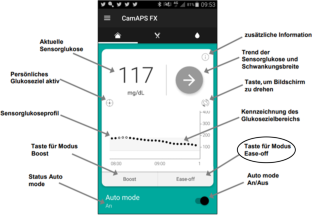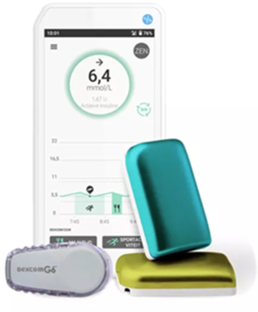Zusammenfassung
Regelmäßige physische Aktivität und Sport sind Grundpfeiler des modernen Typ-1-Diabetes-Managements. In den letzten Jahren verbesserte die Verfügbarkeit von Systemen zur automatisierten Insulinabgabe ([AID] dynamische Insulinabgabe + kontinuierliche Glukosemessung + Dosierungsalgorithmus) die glykämische Einstellung von Menschen mit Typ-1-Diabetes (T1D). Körperliche Aktivität und sportliche Betätigung bieten zusätzliche Gesundheitsvorteile, können jedoch zu Glukosespiegelschwankungen führen, die die derzeitigen AID-Systeme vor verschiedene Herausforderungen stellen. Obwohl klinische Studien und Übersichtsartikel zu AID-Systemen, körperlicher Aktivität und Bewegung veröffentlicht wurden, wird erst im September 2024 beim EASD-Kongress (EASD: European Association for the Study of Diabetes) ein neues Positionspapier zur T1D, AID und Sport veröffentlich werden. In dieser gemeinsamen Stellungnahme der EASD und der ISPAD (International Society for Pediatric and Adolescent Diabetes) werden die vorhandenen Erkenntnisse zu AID-Systemen erörtert und detaillierte Empfehlungen zum Umgang mit körperlicher Aktivität und Sport für Kinder, Jugendliche und Erwachsene mit Typ-1-Diabetes unter Nutzung von AID-Systemen gegeben werden. Somit ist es Ziel dieser Publikation, vorweg Einblicke in die neuen Empfehlungen zu geben und zugleich grundsätzliches Wissen zu physischer Aktivität, Sport und T1D darzustellen. Als Grundmaxime gilt, dass die erläuterten Empfehlungen nur als Erstempfehlungen gelten und weiterführend individualisiert werden müssen.
Abstract
Regular physical activity and exercise are cornerstones of modern type 1 diabetes mellitus management. In recent years, the availability of automated insulin delivery systems (AID; dynamic insulin delivery + continuous glucose monitoring + dosing algorithm) has improved glycemic control in people with type 1 diabetes. Physical activity and exercise provide additional health benefits but may result in glucose fluctuations that present various challenges for current AID systems. Although clinical studies and reviews on AID systems, physical activity, and exercise have been published, a new position paper on type 1 diabetes, AID, and exercise will not be published until September 2024 at the European Association for the Study of Diabetes (EASD) conference. This joint position statement from the EASD and the International Society for Pediatric and Adolescent Diabetes (ISPAD) discusses the existing evidence on AID systems and provides detailed recommendations on how to manage physical activity and exercise for children, adolescents, and adults with type 1 diabetes using AID. Hence, the aim of this publication is to provide preliminary insights into the new recommendations and at the same time present basic knowledge about physical activity, exercise, and type 1 diabetes. In general, it is important to understand that the presented recommendations are only considered as initial recommendations and must be further individualized.





Literatur
Moser O, Riddell MC, Eckstein ML et al (2020) Glucose management for exercise using continuous glucose monitoring (CGM) and intermittently scanned CGM (isCGM) systems in type 1 diabetes: position statement of the European Association for the Study of Diabetes (EASD) and of the International Society f. Diabetologia 63(12):2501–2520. https://doi.org/10.1007/s00125-020-05263-9
Riddell MC, Gallen IW, Smart CE et al (2017) Exercise management in type 1 diabetes: a consensus statement. Lancet Diabetes Endocrinol 5(5):377–390. https://doi.org/10.1016/S2213-8587(17)30014-1
Colberg SR, Sigal RJ, Yardley JE et al (2016) Physical Activity/Exercise and Diabetes: A Position Statement of the American Diabetes Association. Diabetes Care 39(11):2065–2079. https://doi.org/10.2337/DC16-1728
Brazeau AS, Rabasa-Lhoret R, Strychar I, Mircescu H (2008) Barriers to physical activity among patients with type 1 diabetes. Diabetes Care 31(11):2108–2109. https://doi.org/10.2337/DC08-0720
Moser O, Tschakert G, Mueller A et al (2015) Effects of High-Intensity Interval Exercise versus Moderate Continuous Exercise on Glucose Homeostasis and Hormone Response in Patients with Type 1 Diabetes Mellitus Using Novel Ultra-Long-Acting Insulin. Plos One. https://doi.org/10.1371/JOURNAL.PONE.0136489
Phillip M, Kowalski A, Battelino T (2024) Type 1 diabetes: from the dream of automated insulin delivery to a fully artificial pancreas. Nat Med. https://doi.org/10.1038/D41591-024-00013-5
Zimmer RT, Auth A, Schierbauer J et al (2023) (Hybrid) Closed-Loop Systems: From Announced to Unannounced Exercise. Diabetes Technol Ther. https://doi.org/10.1089/DIA.2023.0293
Moser O, Pemberton JS (2024) Rethinking the safety and efficacy assessment of (Hybrid) Closed Loop systems: Should we promote the need for a minimum of exercise data within the regulatory approval? Diabet Med. https://doi.org/10.1111/DME.15305
Zaharieva DP, Morrison D, Paldus B, Lal RA, Buckingham BA, O’Neal DN (2023) Practical Aspects and Exercise Safety Benefits of Automated Insulin Delivery Systems in Type 1 Diabetes. diabetes Spectr 36(2):127–136. https://doi.org/10.2337/DSI22-0018
O’Neal DN, Zaharieva DP, Morrison D, McCarthy O, Nørgaard K (2024) Exercising Safely with the MiniMedTM 780G Automated Insulin Delivery System. Diabetes Technol Ther 26(S3):84–96. https://doi.org/10.1089/dia.2023.0420
Thurm U (1964) Diabetes- und Sportfibel Mit Diabetes weiter laufen. Gehr B, Kirchheim + Co GmbH
Author information
Authors and Affiliations
Corresponding authors
Ethics declarations
Interessenkonflikt
O. Moser gibt an: Unterstützung klinischer Studien: Sêr Cymru II COFUND Fellowship/European Union, Novo Nordisk A/S, Novo Nordisk AT, Abbott Diabetes Care, Sanofi, Dexcom, Team Novo Nordisk, SAIL, Maisels Brauerei, Medtronic AT, EFSD (European Foundation for the Study of Diabetes)/EASD, Falke, BISp., Ypsomed, Medtronic, DiabetesDE. Vortragstätigkeiten: Medtronic AT, Medtronic Int., Lilly, Novo Nordisk, Sanofi, TAD Pharma, ADA (American Diabetes Association); Diatec, AstraZeneca, Ypsomed, Dexcom. Konferenz/Reiseunterstützung: Novo Nordisk A/S, Novo Nordisk AT, Novo Nordisk UK, Medtronic AT, Sanofi, EASD, OEDG (Österreichische Diabetesgesellschaft), DDG (Deutsche Diabetesgesellschaft). Berater: Sanofi, TAD Pharma, Glaice. U. Thurm hielt Vorträge für folgende Firmen: Abbott, AstraZeneca, Berlin Chemie, Dexcom, Diashop, GlookoDiasend, Lilly, Medtronic, Metrix Verlag, MSD, Novo Nordisk, Roche.
Für diesen Beitrag wurden von den Autor/-innen keine Studien an Menschen oder Tieren durchgeführt. Für die aufgeführten Studien gelten die jeweils dort angegebenen ethischen Richtlinien.
Additional information
Hinweis des Verlags
Der Verlag bleibt in Hinblick auf geografische Zuordnungen und Gebietsbezeichnungen in veröffentlichten Karten und Institutsadressen neutral.

QR-Code scannen & Beitrag online lesen
Rights and permissions
About this article
Cite this article
Moser, O., Thurm, U. Sport und Typ-1-Diabetes: Therapieanpassungen und Strategien. Diabetologie (2024). https://doi.org/10.1007/s11428-024-01218-5
Accepted:
Published:
DOI: https://doi.org/10.1007/s11428-024-01218-5

